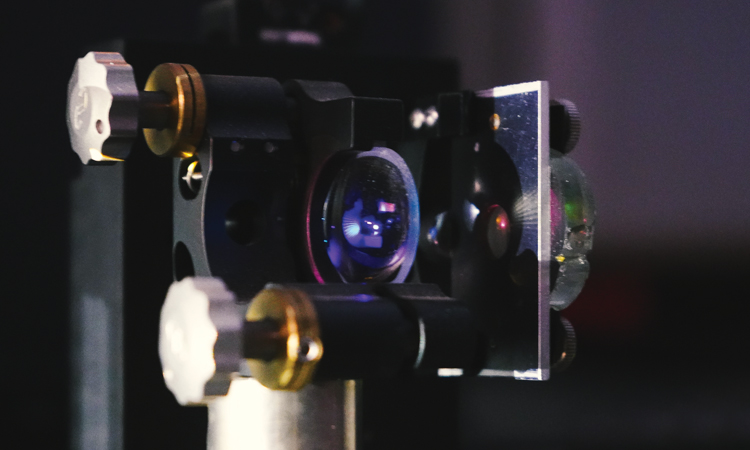 Experimental setup for femtosecond laser irradiation of glasses. [N.J. Tostanoski, Alfred University]
Experimental setup for femtosecond laser irradiation of glasses. [N.J. Tostanoski, Alfred University]
Optical elements and components made with a remarkable material, glass, have played a leading role in the development of the laser over the past six decades. The laser–glass partnership has had a profound impact on research, engineering, defense and medicine, underscoring the role of both lasers and glass as empowerers of science.
The perturbative nonlinear optical effects induced by intense laser radiation, for example, enabled the development of laser spectroscopy. Other advances in science have rested on the ability to generate ever-shorter laser pulses, ultimately enabling fields like femtochemistry—the study of molecular dynamics and chemical reactions on the femtosecond (fs = 10–15 s) timescales at which they actually occur, for which Ahmed Zewail won the 1999 Nobel Prize in Chemistry.
Additional advances in ultrafast science have opened up even the attosecond (as = 10–18 s) frontier. Enabled by high-harmonic generation (HHG) in gases and crystals, nonperturbative nonlinear optical effects induced by a strong oscillating field can generate extreme UV light pulses shorter than 1 fs—fast enough to capture atomic-scale electronic motion.
Interestingly, even as glass has helped enable this basic science, the ability to create and use femtosecond (and shorter) pulses is enabling further understanding of glass itself. A wide range of glass chemistries is important for various industrial applications, and intense laser radiation can be used to probe, understand and process such glasses, exploiting timescales not accessible with thermal processing. The availability of attosecond laser pulses presents an unprecedented opportunity to study and control the state of glass at the atomic scale, in a tiny fraction of a second.
A fundamental understanding of glasses requires thinking both fast and slow, on two different timescales.
The naming of 2022 as the UN International Year of Glass (iyog2022.org) provides an excellent opportunity to highlight how femtosecond laser pluses are revolutionizing glass science and engineering—and to examine how advances in ultrafast science may even help scientists solve the long-standing mystery of glass transition.
The complex nature of glass
Atomic arrangement in a glass is similar to that in a liquid but more tightly packed, raising a question that continues to puzzle scientists: Where and why does liquid end and glass begin? Glass properties are a complex function of chemical composition, temperature, pressure, time and processing history. Thermodynamically, glass is a nonequilibrium material. Microscopically, it is a noncrystalline material without long-range order. Statistically, glass can be described in terms of the ergodicity of the dynamic system—that is, the extent to which a random sample of the system reflects the average behavior of the system as a whole with time.
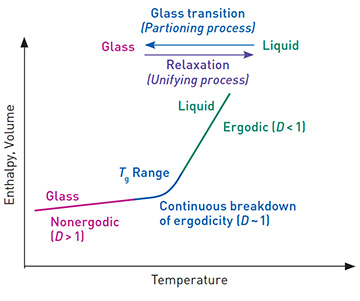 Glass transition versus temperature. [Adapted from J.C. Mauro and M.M. Smedskajer, J. Non-Cryst. Solids 396–397, 41 (2014); CC BY-NC-SA 3.0] [Enlarge graphic]
Glass transition versus temperature. [Adapted from J.C. Mauro and M.M. Smedskajer, J. Non-Cryst. Solids 396–397, 41 (2014); CC BY-NC-SA 3.0] [Enlarge graphic]
A fundamental understanding of glasses requires thinking both fast and slow, on two different timescales. An internal relaxation time (tinternal or τrelaxation) measures the time in which a system “forgets” its historical states, while an external time of observation (texternal or tobservation) measures the time in which properties of the system are measured. The ratio of these timescales is the Deborah number (De), which is defined as tinternal/texternal or τrelaxation/tobservation. The De value of a liquid state is less than 1, making it ergodic. As the liquid cools to a glass, the De value increases to greater than 1, becoming non-ergodic. As the glass transition proceeds, the atoms lose their freedom to rearrange themselves into equilibrium positions and get trapped in a glassy state.
The Deborah number offers a clue to why the development of ultrashort laser pulses has opened so many horizons in glass science. With spatial and temporal control of these pulses from seconds to attoseconds, one can localize and expand the De timescales—τrelaxation versus tobservation—across 18 orders of magnitude.
Beating diffusion
In 1958, Phillip Anderson published a paper that linked a disordered or glassy state to a lack of charge diffusion, leading to the idea of Anderson localization, while Nevill Mott’s extensive work on disordered systems had already attracted the attention of the scientific community. Anderson, Mott, and John Hasbrouck Van Vleck shared the Nobel Prize in Physics “for their fundamental theoretical investigations of the electronic structure of magnetic and disordered systems,” in 1977, and decades of research on understanding the glassy state followed. Not surprisingly, given its importance across a range of disciplines including optics, fused silica has been one of the most studied glass systems.
Glasses absorb femtosecond laser pulses through nonlinear ionization processes that generate transient as well as permanent modifications in the glass’s network structure. Diffusion in most glasses occurs at about 1 µs. Femtosecond laser pulses can therefore defeat diffusion, allowing one to rapidly change atom positions, bonding and linkages and even achieve nonequilibrium states in glasses below the damage threshold. The random network structure of glass allows distortion of bonds and bonding angles under femtosecond laser irradiation.
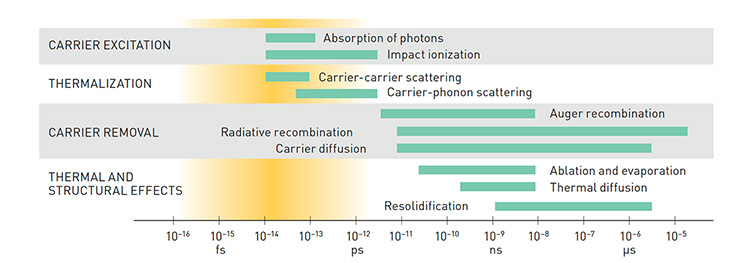 Timescale of physical phenomena during the interaction of femtosecond laser pulses with glass. [Adapted by permission from Springer Nature, S.K. Sundaram and E. Mazur, Nat. Mater. 1, 217 (2002); © 2002] [Enlarge graphic]
Timescale of physical phenomena during the interaction of femtosecond laser pulses with glass. [Adapted by permission from Springer Nature, S.K. Sundaram and E. Mazur, Nat. Mater. 1, 217 (2002); © 2002] [Enlarge graphic]
Femtosecond laser pulses can be tightly focused at or near surface as well as into bulk glass. Though the glasses absorb the laser light in the femtosecond timescale, they undergo changes down to the microsecond timescale. Therefore, femtosecond laser pulses can be used to initiate processes and phenomena in shorter timescales, extending timescales of observation and measurements and enabling an interplay of trelaxation versus tobservation across De values in glass.
Writing into glasses
Femtosecond laser pulses have been used to write directly into glasses, a process called micromachining. Extensive micromachining of many glasses, such as high-silica (SiO2), borate, borosilicate, phosphate, fluorozirconate (ZBLAN) and chalcogenide glasses, has been studied in the past three decades. The laser beams are normally translated in the x–y direction, but by focusing the laser beam at various depths in the z direction, 3D passive and active optical components—for example, waveguides and gratings—can be written into glasses.
Many parameters affect the interaction of femtosecond laser pulses with glass. The parameters critical for successful writing are pulse energy (E), pulse duration (τ), laser light wavelength (λ) and repetition rate (R). The damage threshold intensity depends on E, τ, and numerical aperture (NA). The light intensity is related to the wavelength: I α E × NA2/[τλ2(1 – NA2)]. The parameters generally used to write into fused silica are in the ranges of E = 0.01–10 μJ, NA = 0.011, τ = 40–300 fs, R = 1 kHz to 1 MHz, and λ = 800–1080 nm.
A wide range of features and structures have successfully been written at different speeds for a variety of applications.
Generally, this interaction produces three types of refractive-index modification. Type I modification corresponds to minimal changes in glass structure, usually achieved at low pulse energy. Type II modification involves birefringence due to stress fields caused by gradients in temperature and pressure induced by intermediate pulse energies. This is commonly due to multiphoton absorption when glasses are irradiated above the damage threshold. Finally, when the pulse energies are high, pressure builds up within the volume of irradiation and shock waves are generated, leading to Type III modification, which includes microexplosions and formation of voxels and voids in the glasses. A wide range of features and structures have successfully been written at different speeds for a variety of applications, including telecommunications, 3D optical data storage, biophotonics and imaging.
Recently, a nanograting induced by birefringence using two different femtosecond laser pulses created a 1.5×2-mm2 collage of overlaid images of James Clerk Maxwell and Issac Newton in fused silica. This method of writing invokes dipole–dipole interaction of polaritons and self-organization via an exciton–polariton process.
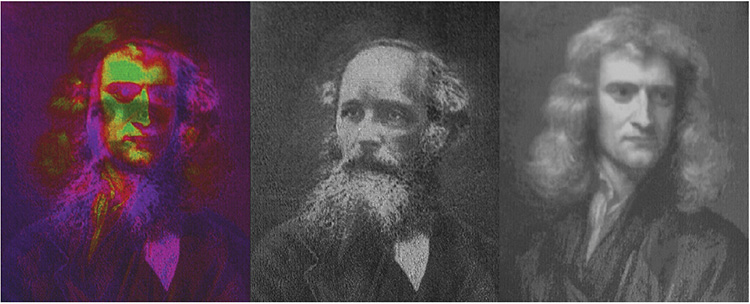 Femtosecond laser pulses in glass enabled a birefringence-induced nanograting “collage” of James Clerk Maxwell (center image, recorded by controlling retardance) and Issac Newton (right image, recorded by controlling the slow axis). [Reprinted from M. Beresna et al., Appl. Phys. Lett. 101, 053120 (2012) with permission of AIP Publishing]
Femtosecond laser pulses in glass enabled a birefringence-induced nanograting “collage” of James Clerk Maxwell (center image, recorded by controlling retardance) and Issac Newton (right image, recorded by controlling the slow axis). [Reprinted from M. Beresna et al., Appl. Phys. Lett. 101, 053120 (2012) with permission of AIP Publishing]
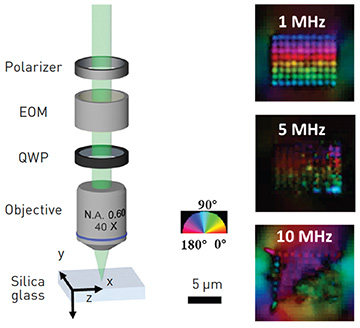 Left: A femtosecond laser-writing setup enabled anisotropic nanostructuring in glass by energy deposition control via near-field enhancement. EOM, electro-optic modulator; QWP, quarter-wave plate. Right: birefringent voxels written at different laser repetition rates (pseudo-colors show changes in local crystallographic orientation). [Y. Lei et al., Optica 8, 1365 (2021)] [Enlarge graphic]
Left: A femtosecond laser-writing setup enabled anisotropic nanostructuring in glass by energy deposition control via near-field enhancement. EOM, electro-optic modulator; QWP, quarter-wave plate. Right: birefringent voxels written at different laser repetition rates (pseudo-colors show changes in local crystallographic orientation). [Y. Lei et al., Optica 8, 1365 (2021)] [Enlarge graphic]
Molecular oxygen produced during writing forms nanopores, which change the refractive index and induce birefringence in the glass. This process has been successfully used to fabricate 5D optical memories in fused silica. The experimental setup, involving a polarizer, an electro-optic modulator, a quarter-wave plate and an objective, enabled highly localized anisotropic nanostructures to be written by starting from an isotropic nanovoid and elongating the void using near-field enhancement. A high repetition rate (MHz) minimized thermal effects during the process. This work demonstrates the feasibility of high-speed, high-density data recording and storage in glasses.
Growing crystals
The nucleation and growth of crystals in glasses and the conversion of glass to glass–ceramics via compositional control and thermal processing are well-known phenomena in the glass community, and growth of many different crystals in various oxide and non-oxide glasses have been reported in the literature. Femtosecond laser pulses are a powerful tool for inducing 3D crystallization in glasses. Laser-induced crystallization in glasses involves complex mechanisms. A wide array of textures, crystals and assemblages can be produced by leveraging all laser parameters, managing heat production and distribution and exploiting various phenomena below and above the damage threshold of a specific glass system. All of this creates a vast palette for glass scientists.
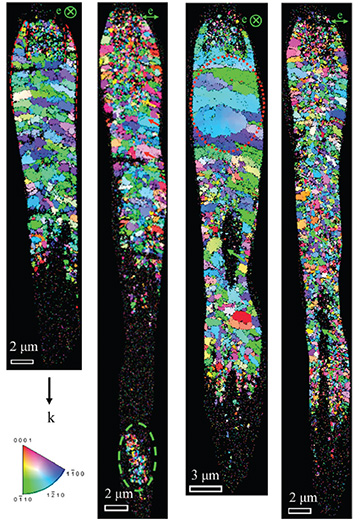 Laser-induced crystallization in glasses. Scanning electron microscopy and electron backscattered diffraction images illustrate laser tracks, with inverse pole figures showing crystallographic orientation along the tracks. The laser irradiates in the top-down direction indicated by the “k” arrow, which is parallel to the laser polarization direction in the first and third panels and perpendicular to the laser polarization direciton in the second and fourth panels. Red dashed lines identify observed areas of complex morphology. [Reprinted with permission from J. Cao et al., Cryst. Growth Des. 19, 2189; © 2019 ACS (2019)] [Enlarge graphic]
Laser-induced crystallization in glasses. Scanning electron microscopy and electron backscattered diffraction images illustrate laser tracks, with inverse pole figures showing crystallographic orientation along the tracks. The laser irradiates in the top-down direction indicated by the “k” arrow, which is parallel to the laser polarization direction in the first and third panels and perpendicular to the laser polarization direciton in the second and fourth panels. Red dashed lines identify observed areas of complex morphology. [Reprinted with permission from J. Cao et al., Cryst. Growth Des. 19, 2189; © 2019 ACS (2019)] [Enlarge graphic]
A model glass system, lithium niobium silicate (33Li2O–33Nb2O5–34SiO2), has revealed captive images with intricate features. High repetition rates facilitate thermally induced nucleation and growth of these crystals. The work suggested that, as laser power increases, three crystallization regimes emerge in this system. In the first regime, glass structure is modified. Then, in the second regime, nanocrystals form embedded in glassy lamellae in the direction perpendicular to laser polarization. As these crystals grow further, a hierarchical micrometer-to-nanometer-scale structure forms, aided by second-harmonic generation and birefringence. In the third regime, the dimensional scale and texture can be controlled by the angle between the directions of laser writing and polarization. This work gives a glimpse of the level of complexity in crystal growth that can be obtained and controlled using intense femtosecond laser irradiation.
Strengthening network structure
Femtosecond laser pulses can be used to change glass structure locally, and thereby to increase (or decrease) the material’s surface hardness without traditional thermal treatment. Recently, femtosecond laser pulses have been used to treat the surface of three commercial glasses: soda-lime silicate (SLS), borofloat (BF) and aluminoborosilicate (ABS). The surface hardness of the BF and ABS glasses increased by about 18–20%, while the surface hardness of the SLS glass was reduced by about 17% with no significant change in surface chemistry or induced residual stress layers.
This differing result is because of the high network modifier content—usually alkali or alkaline earth oxides—in SLS compared with ABS. The addition of modifiers reduces silica tetrahedra and increases Qn species, which depolymerize the silica rings and leave behind a more open structure prone to further laser modification—observations supported by the increase or decrease in THz refractive indices of the glasses. (Qn refers to silicon atoms coordinated to n number of bridging oxygen atoms.) These changes are attributed to Type I modification with no significant local stress fields.
Extensive modeling and experimental studies using advanced structural analytical tools, like Raman spectroscopy, have supported the changes in the bond angle distribution of Si–O–Si and bond length of Si-non-bridging oxygen that have led to densification in the SLS glass due to laser irradiation. Increasing the network modifier content and the laser fluence impact the Si–O tetrahedral coordination, thus increasing Qn species and disorder in the glass. In the case of an alkaline earth aluminosilicate glass system, the laser irradiation has led to a transformation of four-coordinate Al to five-coordinate Al, increasing the density and decreasing average Al–O–Al or Si–O–Si angles due to elongation of these bonds.
To attoseconds and beyond
As the brief review above makes clear, the interplay of femtosecond lasers and glass science has been a fruitful one, leading to practical advances in laser writing and new insights in fundamental glass science. Even so, the question posed at the beginning—the puzzle of the glass transition—hasn’t yet been fully solved. But the availability of even shorter pulses from facilities like the European Extreme Light Infrastructure (ELI) might get us closer (see “ELI: Open for Business,” OPN, January 2020).
Shorter laser pulses also mean higher intensity, enabling study that hasn’t been possible before.
Shorter laser pulses also mean higher intensity, enabling study that hasn’t been possible before. An inverse linear dependence exists between the pulse duration of coherent light emission (microseconds to yoctoseconds [ys = 10–24 s]) and the laser intensity (megawatts to yottawatts per cm2) spanning more than 18 orders of magnitude. Large fields can induce large-scale perturbations in atoms, nuclei and vacuums, producing ultrashort pulses of radiation and particles that can be used to probe ultrafast events in atoms and nuclei in femtosecond, attosecond, zeptosecond (zs =10–21 s) and yoctosecond regimes.
The laser–glass partnership has played a role in pushing ahead with these shorter pulses. A silica glass–based solid-state detector has been proposed for measuring the exact waveform of the femtosecond pulse used in reproducibly generating attosecond pulses for science measurements. Dispersion in a BK7-glass wedge pair has been used to control the phase of attosecond pulses produced by HHG in gases. In addition, HHG has been reported in fused silica and nanostructured fused silica, which show promise for the development of robust and compact extreme UV light sources.
Once again, glasses have reaffirmed their role as empowerers of science. The shorter laser pulses and higher energies achievable at ELI and other facilities will provide unprecedented access to study, understand and modify matter, including glasses, and potentially discover new forms of matter or glass chemistry.
Glass scientists can exploit these tools to achieve extreme energy densities inside glasses; study the interplay of τrelaxation versus tobservation on either side of De = 1, well past femtosecond into attosecond, zeptosecond and yoctosecond timescales; and perhaps at last resolve the mystery of glass transition. A fundamental understanding of these phenomena will ultimately help control the state of glass at an atomic scale in real time. The future of glass science and engineering is extremely bright.
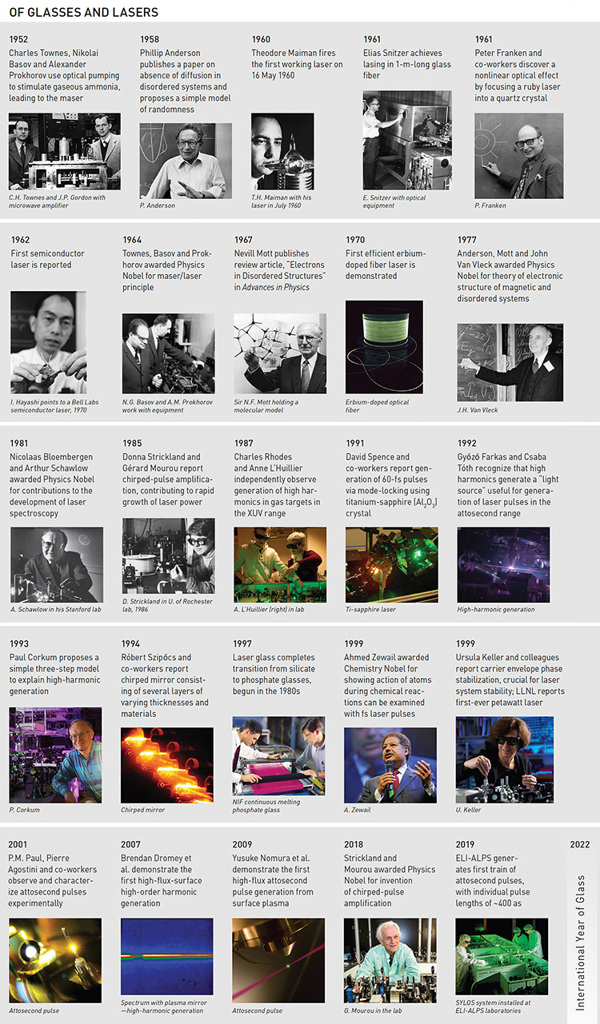 [View timeline credits: optica-opn.org/link/glass-science] [Enlarge graphic]
[View timeline credits: optica-opn.org/link/glass-science] [Enlarge graphic]
S.K. Sundaram is the Inamori Professor of Materials Science and Engineering at Alfred University, NY, USA.
View references and resources: optica-opn.org/link/glass-science.
